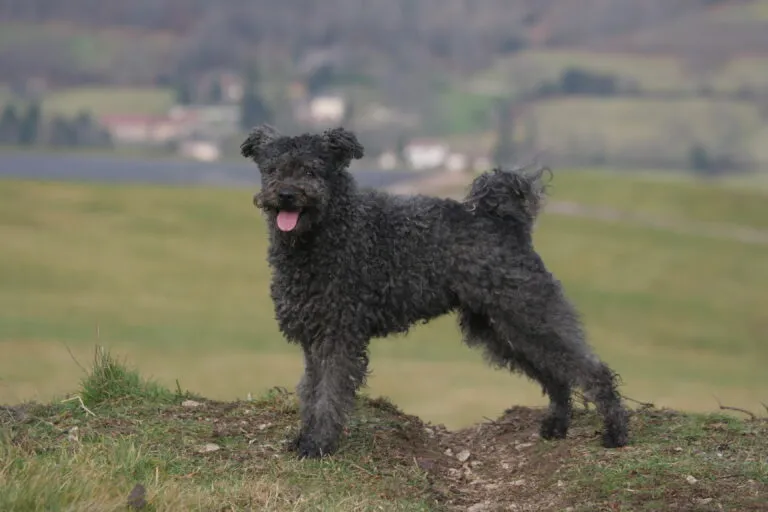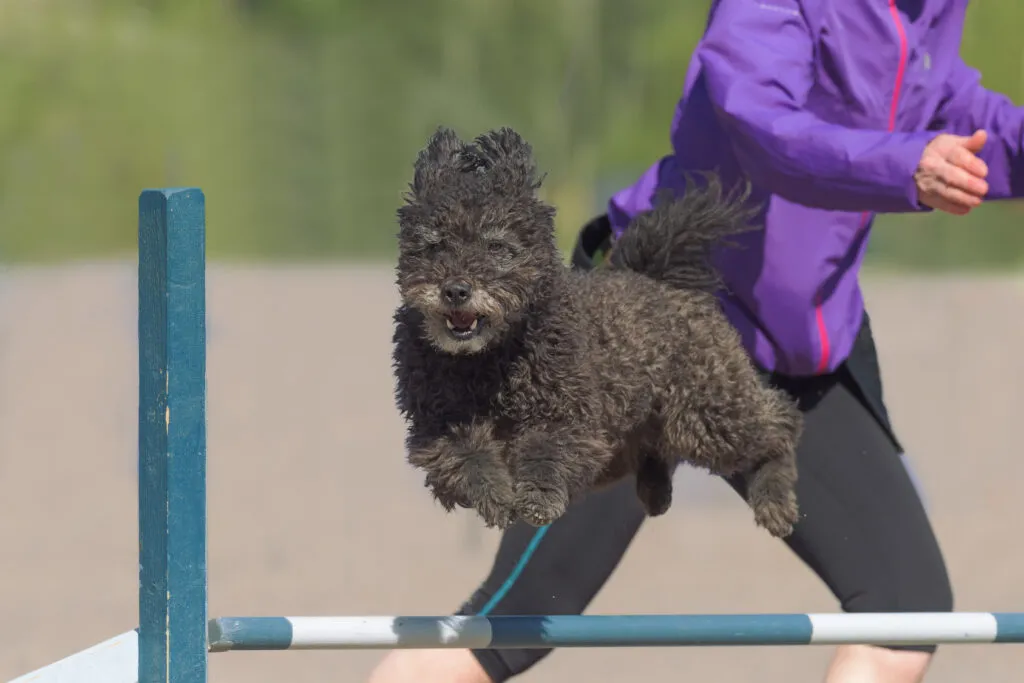Medium Size Poodle
Some lucky Pumi owners, when asked about the breed of their furry companion and responding truthfully with "Pumi," often get a knowing nod and, "Oh yes, that’s the new Poodle mix!" Far from it! Read on to discover more about this nearly 300-year-old breed from Hungary.

© Dogs / stock.adobe.com
The Pumi is an Hungarian herding dog known for its curly coat and erect ears, typically seen in shades of grey, black, fawn, or white
Admittedly, at first glance, the Pumi does look a bit like a Poodle with its curly fur. However, the unmistakable trademark of this breed is its cheeky-looking erected ears, giving the Pumi its unique appearance.
These small dogs weigh between 10kg and 15kg, with a shoulder height of up to 47cm.
The bristly top coat with a soft undercoat adorns the breed in colours of grey, black, white, and fawn – with grey Pumis being the most common, starting off black at birth and lightening as they age.
The Pumi is likely a cross between the Puli, the smaller of the two long-haired Hungarian shepherd breeds, with French sheepdogs and German terriers.
The breed’s origins trace back to the 17th and 18th centuries. Initially considered a Puli variant, Pumis were recognised as a separate breed in 1920. While the Puli evolved more into a distinct-looking companion dog, the Pumi remained primarily an uncomplicated and versatile working dog on Hungarian farms, mainly used for herding livestock and sometimes for hunting.
Today, while Pumis can be found as family companions, the breed is still extremely rare outside Hungary.
The breed is lively, very intelligent, and needs tasks to stay occupied. As a herding dog, it is accustomed to working independently. Pumis are incredibly loyal to their pack and love to guard their territory, often keeping their distance from strangers.
Ensure strangers do not pet your dog out of nowhere, allowing your Pumi to maintain its typical reservation. It needs time to warm up. Your bond with your family will be stronger, and this little ball of fur will appreciate your affection.
In serious situations, a Pumi is ready to defend, showing some fierceness, requiring experienced handlers. Combined with its desire to work, it is not necessarily suitable for beginners. Also, it tends to be quite vocal, though this is usually not a problem for a balanced Pumi with meaningful tasks.
As with many original working breeds, only a well-exercised dog is predisposed to good behaviour. If bored, it will find its own entertainment, often not to the owner’s delight!
Otherwise, the breed is eager to learn and responds well to consistency and praise while respecting its independent nature. If you say “No” and then let the dog jump back on the sofa, don’t be surprised if the smart Pumi tries to take charge.
Extensive socialisation greatly benefits this breed. Choose a breeder who already familiarises the puppies with various situations and consider enrolling your young dog in a puppy play class. This will help it build positive interactions with other dogs of all breeds and sizes, enhancing its social skills.
Of course, attending a dog school can also make training your Pumi easier.
 © Juha Saastamoinen / stock.adobe.com
© Juha Saastamoinen / stock.adobe.com
Apart from skin and fur issues, which can be more common in some Pumis than in the average dog, this robust breed has no tendency towards increased health problems.
These agile dogs can live up to 16 years.
The best foundations for a long and healthy canine life are a good breeder and a suitable diet. A dog is a carni-omnivore, meaning it is a meat-eater that consumes not only muscle meat but also the prey’s fur, bones, and stomach contents.
In the wild, wolves also regularly – not just in times of scarcity – eat grass, berries, and roots, as well as the dung of herbivores. Therefore, when choosing an appropriate food for your pet, ensure meat is the main ingredient, complemented by high-quality components. Avoid low-quality grain, which serves only as a cheap filler.
For a puppy, four to five meals a day are suitable, while two portions suffice for an adult Pumi. Allow your dog some rest after eating, perhaps a small digestion nap. Manufacturer recommendations on daily food quantities are guidelines that vary depending on your dog’s activity and constitution.
Weigh your Pumi regularly to ensure it maintains a healthy weight. Occasionally, you can supplement its diet with cottage cheese, low-fat quark, cooked potatoes or rice, and certain fruits and vegetables – avoid grapes and all onion plants, including garlic.
The care of a Pumi’s curly coat is straightforward: Brush it weekly with a coarse comb to prevent matting. Start this routine early, right after the puppy joins your home, with a soft brush, praising it afterwards. After grooming, check your pet’s ears and claws. If needed, clean its ears with a special dog ear cleaner.
Typically, a Pumi wears down its claws naturally, but you might need to trim them with a claw cutter, especially for older dogs – consult your vet if unsure. Some Pumi owners regularly trim their adult dog by pulling out loose fur with a special trimming knife. This is only necessary for Pumis with very soft hair.
It is usually unnecessary for those with the desired wiry top coat balanced with soft undercoat. For hygiene, consider carefully trimming the fur around the anus and in front of the eyes for better visibility.
Some dog owners introduce brushing their dog’s teeth with special dog toothpaste and toothbrush early. Regular brushing is excellent for maintaining healthy teeth into old age. Alternatively or in addition, give your Pumi dental hygiene snacks or dried chew items for dogs. Occasionally, a few chunks of raw beef also support dental care.
It’s worth repeating: Only a well-exercised Pumi is a pleasant companion. Underutilised dogs of this breed soon become hyper-nervous and behavioural problems can arise. It’s up to the owners to be well-prepared for the high exercise requirements of a Pumi before bringing one home.
If unsure, this hardworking breed might not be the right choice. With a Pumi, you’ll never be bored: these attentive bundles of energy are always ready for adventure and love outdoor activities. They are excellent watchdogs and perfect for various dog sports like agility, dog dancing, flyball, or mantrailing.
Discover what brings you both the most fun. The breed generally enjoys activities that engage its smart mind. Begin physical training only with a fully grown Pumi and gradually increase the intensity. Then your dog will also happily join you for jogging. This lively herding dog feels especially comfortable with access to a fenced garden.
No wonder more dog enthusiasts appreciate the lively nature and charming looks of this breed and want a Pumi as a daily companion. But what should dog lovers with a Pumi wish understand about themselves? As a great nature lover, the Pumi does not belong in a city, though it could be kept there.
A proper Pumi’s life involves plenty of green spaces to explore and, ideally, a fenced garden that the dog can roam and guard in all weather. Couch potatoes should avoid a Pumi as it needs plenty of outdoor activities, rain or shine. Novice dog owners should seek experienced help with training.
Otherwise, the smart herding dog might take the lead. The breed is known to be child-friendly, but children should already understand how to interact respectfully with animals – this can form a lifelong friendship.
However, never leave small children unsupervised with a Pumi, as it might interpret playful roughhousing between kids as a threat and try to protect its pack member. Pumis can get along with cats if accustomed to them as puppies. Otherwise, the terrier instinct in the breed can sometimes complicate coexistence with cats.
Remember, bringing a Pumi into your home means taking on the responsibility for its entire life – this includes the daily time commitment and considerable costs.
Initial expenses include the price of a healthy dog from a breeder, possibly distant travel to the breeder, and the basic equipment: bowls, lead with harness or collar, dog blankets and beds, car travel safety gear, and grooming tools from combs to tick removers.
Additionally, consider the ongoing expenses such as high-quality food, dog liability insurance, and regular vet check-ups. Unanticipated vet visits can quickly become expensive – be prepared for this before getting a dog.
If you have fallen in love with this charming breed’s character and are well-prepared for a harmonious life with a Pumi, it’s time to start your search! This can be challenging, depending on your location, as the breed is still scarce, and there are usually only a few breeders in each country outside Hungary. Contact clubs for Hungarian herding dogs for assistance in finding a breeder.
Once you find a suitable breeder, don’t hesitate to travel even long distances to meet them and their dogs. This meeting allows you to see if a particular Pumi puppy is a good match for you and assess the parents’ temperament and health. A responsible breeder will explain their breeding goals regarding health and type and will also ask you some questions to ensure you can provide a good home.
When you bring your Pumi home at around eight to ten weeks old, it will have a pedigree, be dewormed, and vaccinated – don’t forget to keep up with booster vaccinations. As Pumis are rare outside Hungary, you won’t likely find a purebred Pumi in rescues if looking to adopt an older dog.
However, many animal rescue organisations rehome Hungarian dogs seeking new homes. Since Pumis without pedigrees were often used as working dogs on Hungarian farms, a rescued dog might be a Pumi or a Pumi-mix. Some of these dogs might have negative experiences with humans and require knowledgeable care. Communicate thoroughly with the rescue organisation to match your expectations and circumstances with the right dog.
Avoid allegedly purebred Pumi puppies sold without pedigrees from dubious sources – this only supports the profit-driven puppy trade focusing on money rather than maintaining the breed’s characteristics, temperament, and health. A Pumi-mix from a rescue is likely a better choice!
We wish you much delight with your energetic Pumi!
Fans of the Bearded Collie agree that those who aren't familiar with this dog breed simply have to get acquainted with it. And those who have experienced how a Bearded Collie bolts across meadows with its flowing fur, how it rolls around full of energy and joy and how it attentively and observantly takes into account its owners wishes become simply addicted to this original dog breed and its unique charm.
The Goldendoodle isn't a breed, but a pairing between Golden Retrievers and Medium or Standard Poodles. Marketed as a low-maintenance dog for allergy sufferers, this hybrid is enjoying increasing popularity amongst dog lovers, similar to the Labradoodle.